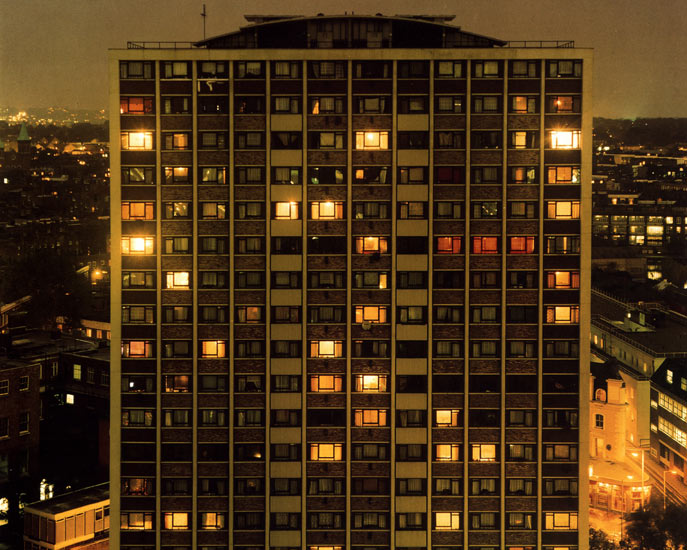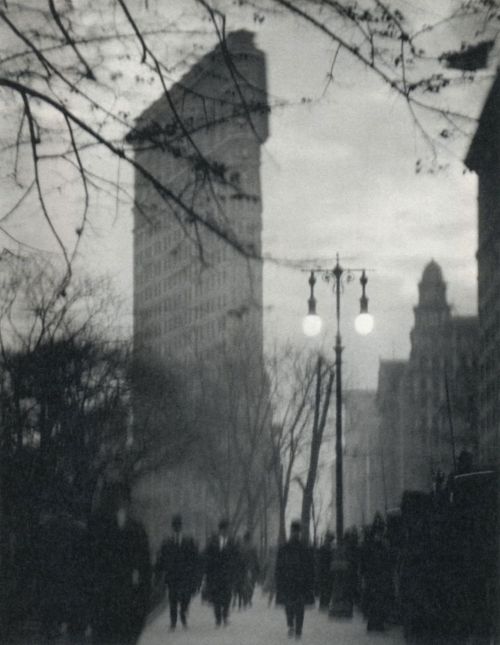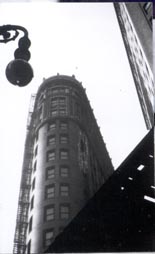Deconstructing Environmental Photographers
"For many contemporary photographers the city remains an enigma: a spectacle that cannot be resolved. The experience of the contemporary urban fabric is endlessly complex and ambivalent." For this reason, it is possible for photographers of the urban environment to take so many different approaches in portraying it the way they do.
Rut Blees Luxemburg
Luxemburg works at night; shooting her images using long exposures to capture the street lights and other lights on in buildings etc. This technique leads to the majority of her work having a warm tone. This accurately portrays night time scenes in their reality aided by the physical lack of people and figures. An opinion of Luxemburg is that she shows "humanity within empty urban spaces, areas that are rarely thought of as beautiful or warm yet hold so much human life."

Luxembourg is a German photographer. When she visited London she noticed the very visible high-rise buildings in the city due to how little of them there were and the difference between London and Germany. The visibility from them is what interests Luxembourg. As well as her photo being of an elevated view, it has been taken at one - the 16th floor balcony of an opposite building. This was in the 90s when buildings like this were much more open and not restricted so much. She was free to wonder up and take the photograph. She has used a large depth of field to include all of the detail in the whole building and the focus is of the building while it is centred compositionally. The tonal range of the image is vast as there are dark blacks (mainly in the background where things start to disappear) and bright highlights in the lit windows of the tower block. The lighting conditions of her image is ambient with a long exposure as is common with her work. To fully capture the image, Luxemburg used a large format camera with an exposure time of 10 minutes.
Commenting on her own work, Luxemburg views her photograph as a "living sculpture" in the sense that she sees the building as having a sculptural quality to it but also the presence of people in the building during her exposure - watching tv and turning on and off lights as they entered and left rooms. Therefore Luxemburg's visual strategy to representing the city was focused on both the aesthetics and the inhabitants.
This image of Luxemburg's on the right is startlingly different to the previous. Rather than compositionally and perspectively perfecting her image, this photograph in particular looks more like a snap shot; less thought through and considered.
This image, unlike her other and unlike most of her work, includes arbitrary things like fencing just visibly along the bottom; a small brick building on the left and an element of nature creeping in at the top. Again, she has evidently utilised the ambient light, and focussed on the building where there are signs of humanity as she has admitted she likes to show in her work, and therefore the objects in the foreground are out of focus such as the leaves.
There are clear differences between this photo and her former image: it has not been taken from an elevated view but a street level view; it has not been controlled perspective wise and centred like her other work; and the tonal range is not as great because there are less dark shadows. However, Luxemburg has still managed to portray the existence of life through using a theme of lit windows in both of her images.
Luxemburg also photographs abandoned spaces in urban environments. The composition of this image is very interestingly divided into two halves with the ambient light causing the left side to be brighter and warmer in tone. The range is similar to the rest of her work: bright highlights and black shadows. She has also suggested a sense of humanity in the image but through a different method than her other photographs. The graffiti and markings demonstrate previous human existence which she is interested in.
Her focus is on the middle of the image; the depth of field not either of the two extremes - detail can be drawn from the whole photograph. The camera position is at a standing level. Like all of her night shots she will have used a tripod for a long exposure in the ambient light. The mood of this piece comes across as calm. Luxemburg hasn't cut any corners in representing this space as it is. A viewer can clearly see the grime on the wall and the dirty ground but they are not the focus of this space in this particular photograph. I recognise the atmosphere and the tone and the abandonment. It doesn't come across as to me as just another dirty underground passage.
Richard Wentworth
Wentworth uses the medium of photography to document his sculptures of every day life and other occurrences. Like Luxemburg, he acknowledges the presence of human life through creative and interesting devices such as this:
Wentworth has captured this makeshift action which someone has used to keep open their window. The photograph has been taken with a shallow depth of field; evident through the out of focus foreground and surrounding wall. The focus of the image is the teacup because it is the object which is serving it's purpose and holds more importance than the rest of the image. The camera position is at window sill height to relate to the teacup and document the action properly.
Wentworth's visual strategy seems to be focussing on actions of the public and how they behave towards the urban space and how they change it. Perhaps he is documenting the marks we make on the environment. Unlike Luxemburg who seems to focus on much larger spaces and themes, Wentworth's focus is much smaller: he does not photograph cities and buildings but the marks humans leave on them.
This image of Wentworth's is simply of a bottle stuck between two sticks. The composition seems inconsiderate, the colours common and the mood non existent. It seems to me that this image is very lacking in photographic skill and I cannot appreciate it's purpose as it seems there is none. The previous image was taken to capture something. There is nothing of worth in this image.
However, like his other work the depth of field is shallow and he has photographed an object put somewhere by someone. This shallow depth of field draws attention to the focus of his image: it's not a photo of a tree and bottle in the street, it is a photo of a tree and a bottle. This someone is unknown though which is a theme which seems to run through his work. It is obvious the lighting conditions are natural - a similarity between Wentworth's and Luxemburg's. Some differences between the two approaches to representing urban space is the camera angles in some cases and the tonal range. Wentworth is looking down at his subject and his tonal range is not as vast in any of his work as Luxemburg's is.

In this photograph of Wentworth's he has captured a concrete imprint of a footprint which is filled with water. It is a close up which makes the depth of field unclear. Unlike any of the previous photos I have explored the camera angle of this image is a birds eye view looking down on the focus of the image. The lighting is clearly ambient and the tonal range is barely there.
Like the rest of his photographs this seems like a snapshot which suits his approach to presenting the urban space by documenting humanities effect and presence. In process and technique his images are very different to Luxemburg who is a lot more considerate.
Vera Lutter
"Instability, uncertainty, suspense, and monumentality are entities that I consider and think about; they inform my work."
Vera Lutter is famous for her black and white photographs of architecture and cities created by using the camera obscura technique. She uses this because she views her camera as an architectural device and enjoys the relativity of this to her work of architecture. Her visual approach to portraying the urban space is intended to suggest the unfamiliarity of it - she changes the image and makes it look unfamiliar. The camera obscura allows light to pass through an aperture in a dark room and the image is projected, inverted, onto photographic paper which Lutter hangs on the wall to create paper negatives as an end result. At a glance her work looks like black and white night time shots but on closer inspection it becomes obvious they are not.

This image of Lutter's has been taken from an elevated view like Luxemburg's image of a London tower block. This means more is captured in the image. She also uses a large depth of field to ensure maximum detail in the cityscape and emphasise the geometric scale. There is a great tonal range in this image of the negative as there are very dark blacks and very bright whites. The focus seems to be directed on the closest building on the right which stands out among the other.
It is very repetitive and geometric in it's lines and shapes: the straight structures of the buildings, the long straight roads, the same sized windows patterned over the buildings. Lutter was commissioned by The Museum of Contemporary Photography to photograph Chicago and this geometric approach was the one she chose to represent the city. This is evident in other images of hers but this aspect of her photographs relates to Luxemburg's technique.
Lutter's image of Campo Santa Sofia in Venice is of classic Venetian buildings disappearing into the distance, two neat rows of gondolas and a tall building with windows and balconies.
The depth of field Lutter has chosen to use in her photograph is not particularly shallow, however; the soft reflections of the boats due to the long exposure make it look like a shallow depth of field at first glance. Despite the tonal range including dark blacks and bright highlights, the image is quite contrasted causing the involvement of less grey mid tones and therefore lowering the tonal range. This is a difference to her previous image which is a lot flatter.
This image, like the previous, is very geometric subject wise - the architecture and transport is very repetitive. This is like the first image of Luxemburg's I explored in the sense of repetition involved in architecture. It has been taken from an elevated view; again as seen in all the artists works, enabling more of the urban landscape to be included in the frame and different levels to be included like a view of each balcony level which would not be visible from a street level view.

This negative of Lutter's is a very different scene to the majority of her work which are of architectural structures and cities. While this image includes a very different subject, it seems a different approach has also been taken to photographing it. The angle it has been taken at is a very low ground level unlike her other work. The view is pointing slightly up towards the Pyramid to include the whole monument in the frame. The level is slightly at an angle which is also different to the rest of her work but relates to Wentworth's more inconsiderate compositions. The tonal range is similar to her image of venice: there is not a vast mid range but a big contrast.
A clear similarity between Luxemburg and Lutter is the long exposures chosen for their work (somewhere Wentworth doesn't fall into) Luxemburg uses it for involving and working with ambient light in her photography whereas it is difficult to gather Lutter's means as she has created black and white paper negatives - a major difference between hers and Luxemburg's and Wentworth's positive colour images. Although, Lutter's long exposures are relative to her interest of the themes of the realities of time and space which she tries to convey in her work and suggests why she has made this choice. Wentworth has no need for long exposures - photographing in natural daylight and objects falling more under the still life category.
















































